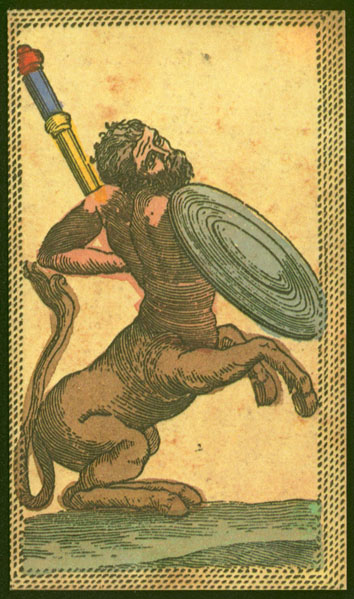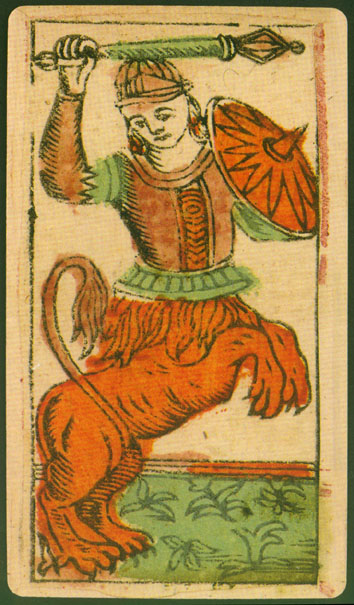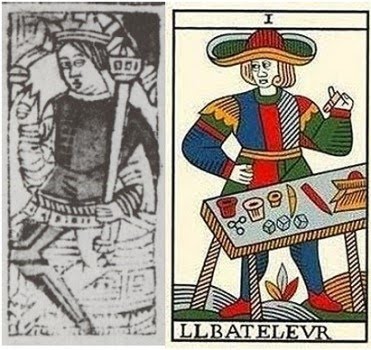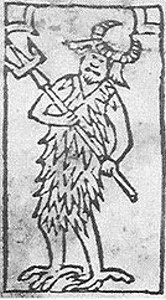Kaplan vol.2 pag.281 presents an uncut sheet belonging to the Museum of Fine Arts, Budapest. The museum owns two copies of the sheet: both copies include the same cards. The second copy (pag.282) was not coloured. Kaplan denotes this two sheets as “Group 5”: the Museum has 8 groups of sheets, all dating to the fifteenth or early sixteenth century.
The upper two rows of the Group 5 sheets present the four aces and the pips of Baton (only the ten is missing). The pips present the numbers written in Italian. In order to read the numbers, the image must be “flipped”, so I wonder if the engraver “forgot” to mirror what he was writing, or if Kaplan's illustrations have been accidentally flipped. On the flipped image, the second row reads rather easily “nove”, “octo”, “sete”, “seo”, “cniqe” (sic), “quatro”.
The Court Cards are very interesting. I feel rather sure that this is not a Tarot deck, because there are exactly twelve Court Cards: it is unlikely that this is a coincidence. In the suit of Cups, the Page and the King are replaced by a “female page” and a Queen. This suggests that the suit of Cups could already be interpreted as feminine during the Renaissance. Each knight rides a different animal: the Knight of Swords rides a simple horse, but the other animals are fantastic beings.
The Page of Batons also is very peculiar. Kaplan's description is: “male page of staves with hairy, apelike body, holding a shield decorated with a cross”. This figure seems to represent the “homo selvaticus” (wild man) that can be seen in many ancient works of art:
http://it.wikipedia.org/wiki/Uomo_selvatico
http://de.wikipedia.org/wiki/Wilder_Mann
http://en.wikipedia.org/wiki/Wild_man
Re: Budapest uncut sheets (Group 5)
2Some early Hunting decks have a suit of Wild Men (along with Birds, Stags, and Flowers).The Page of Batons also is very peculiar. Kaplan's description is: “male page of staves with hairy, apelike body, holding a shield decorated with a cross”. This figure seems to represent the “homo selvaticus” (wild man) that can be seen in many ancient works of art:
Re: Budapest uncut sheets (Group 5)
3I thought the male female division of the suits was very early?
Does indeed appear to be a typical wildman.
Love the knights(?) riding on centaurs (?) and cockerels!
What does the writing say on the banners across the center of the wand pip cards?
Does indeed appear to be a typical wildman.
Love the knights(?) riding on centaurs (?) and cockerels!
What does the writing say on the banners across the center of the wand pip cards?
Re: Budapest uncut sheets (Group 5)
4Yes, probably the first in the Michelino deck description of ca. 1425.SteveM wrote:I thought the male female division of the suits was very early?

The knights in Minchiate later appeared with men-animal mixing ...
see:
http://trionfi.com/m/d05113.htm
or
http://trionfi.com/i/
(choose one motif, go then to the end of appearing list and you'll find some Minchiate decks - click on "deck")
Huck
http://trionfi.com
http://trionfi.com
Re: Budapest uncut sheets (Group 5)
5According to Kaplan, they are the number values of the cards. He says they are Italian (with an archaic orthography).SteveM wrote: What does the writing say on the banners across the center of the wand pip cards?
For instance, the two of batons might say "duobus" (the "-us" is an abbreviation) - unless it is "duo bs", the "bs" being an abbreviations for "bastoni". The eight says "otto", the nine "nove", the five "cinqe" (should be "cinque"), etc.

Re: Budapest uncut sheets (Group 5)
6Thanks, my books are still in England.Ross G. R. Caldwell wrote:According to Kaplan, they are the number values of the cards. He says they are Italian (with an archaic orthography).SteveM wrote: What does the writing say on the banners across the center of the wand pip cards?
For instance, the two of batons might say "duobus" (the "-us" is an abbreviation) - unless it is "duo bs", the "bs" being an abbreviations for "bastoni". The eight says "octo", the nine "nove", the five "cinqe" (should be "cinque"), etc.
Re: Budapest uncut sheets (Group 5)
7I have often read the swords and batons of the Minchiate are centaurs, and the cups and coins sphinxes, if true this may reflect the distinction made of these two pair of suits; however, it does not appear to me that these descriptions match with what you see on the cards.Huck wrote: The knights in Minchiate later appeared with men-animal mixing ...
The fiorentine swords/batons shows two centaurs, then there is a lion body and a winged serpent/dragon body, which could be two sphinxes, though of two different types (I have posted elsewhere examples of the sphinx with serpentine body).
But the Al Leone, which is also frequently described as bearing two centaurs and two sphinxes, appears to me to have the bodies of a horse, a lion, a winged dragon/serpent, and a panther/leopard.
But this is different to our cut sheets, the knight is not a centaur, but is riding a centaur (?well, some kind of human headed animal), or a cockerel (I am presuming those are knights riding the cockerels?)
Re: Budapest uncut sheets (Group 5)
8The Baton knight ..

at
http://trionfi.com/m/d05114.htm
is not a centaur, though it is one in d05113. Coins and Cups do not show the same sort of Sphinxes. But agreed, these are a men-animal mix and the other are riders.

at
http://trionfi.com/m/d05114.htm
is not a centaur, though it is one in d05113. Coins and Cups do not show the same sort of Sphinxes. But agreed, these are a men-animal mix and the other are riders.
Huck
http://trionfi.com
http://trionfi.com
Re: Budapest uncut sheets (Group 5)
9That is right, as I said, the Fiorentine shows the swords and batons as centaurs, if the cups and coins are sphinxes as they are frequently described, they are of different sorts: in the Al leone all four are different (horse, lion, dragon, panther).Huck wrote:The Baton knight ..
http://trionfi.com/m/d05114.htm
is not a centaur, though it is one in d05113. Coins and Cups do not show the same sort of Sphinxes. But agreed, these are a men-animal mix and the other are riders.
Re: Budapest uncut sheets (Group 5)
10To me what is most interesting about the Budapest sheet is its King of Staves, with his hand like the Noblet Bateleur's. As I said on the "Magician" thread (viewtopic.php?f=23&t=384&start=30#p6518), this King of Staves suggests to me that the Bateleur's phallic hand is not due to the breaking off of any wand, but a standard representation of sexual generativity, similar to the green sleeves and gloves in the PMB Staves.

So the question arises, what is the relation of the Budapest sheet 5 to the Noblet?
Either the Budapest sheet's card is part of a tarocchi deck or it is not. If it is a tarocchi, the relationship to the Noblet is closer than if it is not.
Marco wrote,
Even if the Budapest 5 is not a tarocchi, it seems like there was a lot of cross-fertilization between tarocchi and non-tarocchi decks. The Budapest 5's aces are very much like the Noblet's. The hairy knight has something like his his mate in the Rosenwald Devil. And so on.

So it seems to me that the Magician's odd hand could reflect a pattern rather than a broken piece of wood.

So the question arises, what is the relation of the Budapest sheet 5 to the Noblet?
Either the Budapest sheet's card is part of a tarocchi deck or it is not. If it is a tarocchi, the relationship to the Noblet is closer than if it is not.
Marco wrote,
I do not understand Marco's reasoning, that if there are twelve courts, i.e. three courts per suit, it is not a tarocchi deck. How do we know that? Say more. I notice that in other uncut sheets pictured in the same chapter of Kaplan, ones that clearly are tarocchi (because they include trumps), we also don't see four courts per suit. In one or two, we see only males and no queens. In another, we see a female page of coins and a queen of coins but no king. It seems like there was room for variation. Or have I missed something? You can say, well, we just don't have the missing queen or king. But the same might be true for Budapest 5.The Court Cards are very interesting. I feel rather sure that this is not a Tarot deck, because there are exactly twelve Court Cards: it is unlikely that this is a coincidence. In the suit of Cups, the Page and the King are replaced by a “female page” and a Queen. This suggests that the suit of Cups could already be interpreted as feminine during the Renaissance. Each knight rides a different animal: the Knight of Swords rides a simple horse, but the other animals are fantastic beings.
Even if the Budapest 5 is not a tarocchi, it seems like there was a lot of cross-fertilization between tarocchi and non-tarocchi decks. The Budapest 5's aces are very much like the Noblet's. The hairy knight has something like his his mate in the Rosenwald Devil. And so on.

So it seems to me that the Magician's odd hand could reflect a pattern rather than a broken piece of wood.
